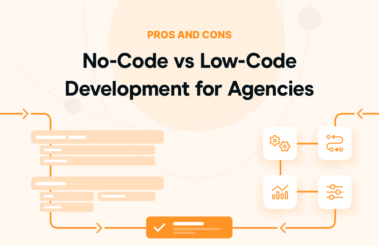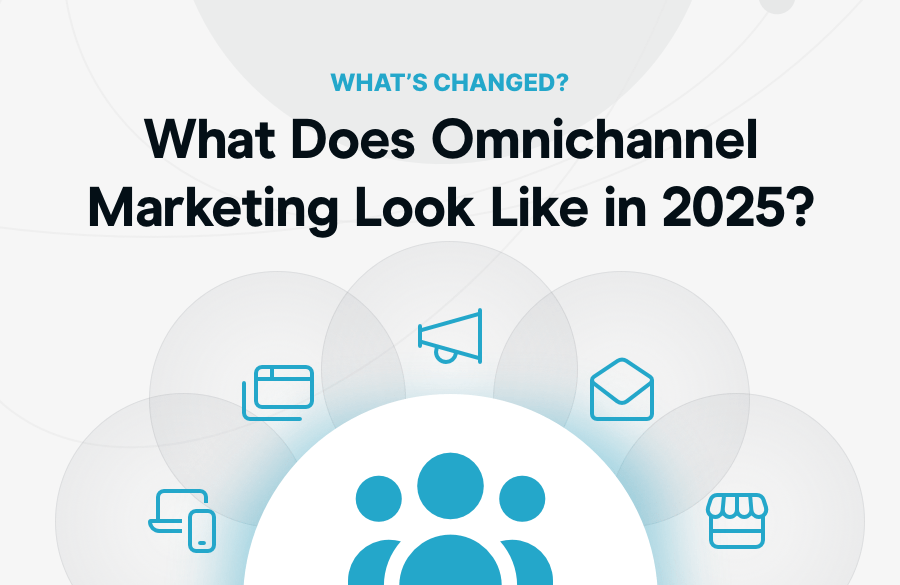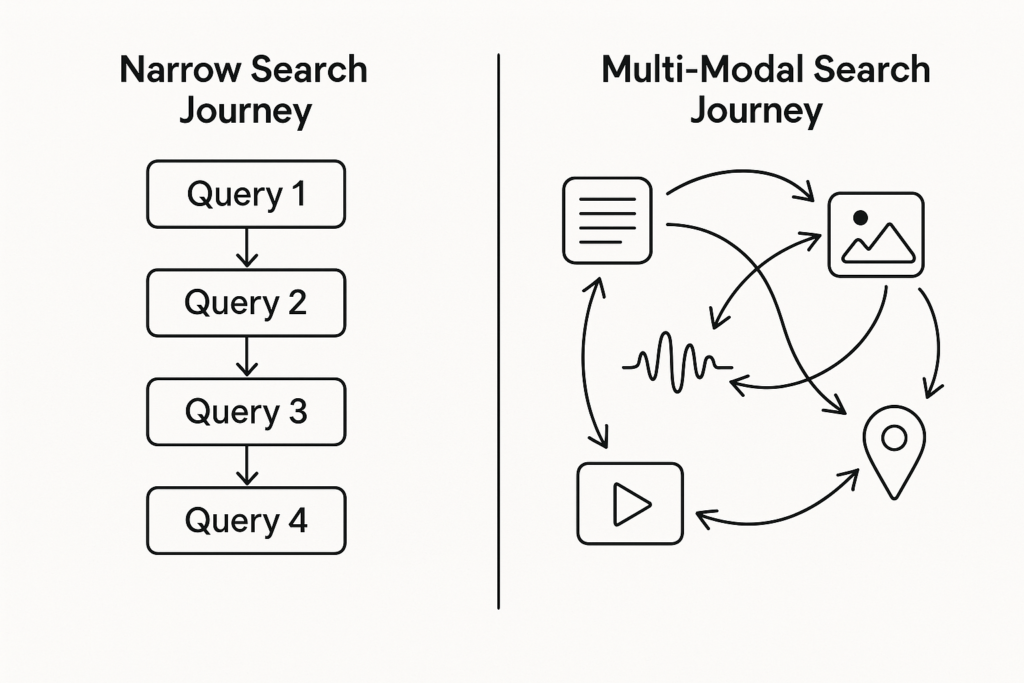
No-Code vs Low-Code Development for Agencies
- •
- 8 min read

Got Omnichannel?
Nope. That’s a 1990s Multi-channel.
In 2025, that approach is about as effective as a flip phone at a TikTok convention. Scratch that – your flip phone flex would probably take you viral!
Online Marketing may look smooth on the outside, but the reality is it’s a bumpy ride. Customer journeys are tangled. Messy. People discover a product on Instagram during breakfast, check reviews on YouTube during their commute to work, add it to their cart on their phone during a team meeting, and finally buy it after an email from WooCommerce nudges them on their way home.
“Multi-modal means multi-platform, multi-surface, and multi-behavior.”
Search Engine Journal
Omnichannel is the reality of the customer journey and it’s not always trackable or traceable to a specific source. It reminds us of the Family Circus cartoons where the blonde kid makes circuitous journeys (ex from 8/15/25) to do a simple task. Instead of the old top of funnel journey, you need to take a “multi-modal approach” as SEJ calls omnichannel marketing.

Customers of all ages are asking chatbots questions, discovering products on social media, abandoning carts, and jumping devices — all before clicking “Buy Now!” One bad (or bland) handoff, and your client loses another sale — probably to that vibe code hustler with the Pinterest shop.
Listen. If your agency’s playbook hasn’t adapted to the new, scattered reality of customer journeys, your clients’ brands are badly lagging. You need to get the lag out. Let’s see how.
Let’s skip the fluff: Omnichannel is about profit.
If your clients’ customer experience isn’t smartly stitched together, they’re leaking revenue at every turn; and it’s better if you tell them up front than wait for them to ask.
Omnichannel isn’t a trend – it’s how your competition is selling. Right now.
“Companies with strong omnichannel strategies retain 89% of their customers vs. 33% for companies with weak strategies.”
Porch Group Media
Picture this:
Sarah (from the local bakery, remember?) starts a chat on your website, gets distracted, then follows up via email that afternoon. She doesn’t have to restate her issue. Her order history is accessible. Maybe the support agent even references her earlier abandoned cart — without sounding creepy.
This isn’t CRM magic, it’s customer sanity.
Brands winning omnichannel treat context like gold. If they don’t, they’re toast.
Agency move: Map every stage where context gets lost. Are email and live chat actually synced? Or will a customer still have to say, “I already told the last person this.?”
You can wire up every personalization engine in existence, but if your website takes 8 seconds to load, congrats! You just lost that customer.
Speed isn’t “nice to have.” Your smartest messaging, best design, and most creative retargeting mean nothing if the digital experience crawls.
Agency move: Run speed audits. Show clients the bounce rate at 3+ seconds, then at 5+. Frame performance as the backbone, not the afterthought.
Insider Tip: Omnichannel insights are only as good as your infrastructure. See how Rocket.net’s performance stack enables real-time data sync and ultra-fast delivery.
That LinkedIn post didn’t spike sales on its own. But three days later, the reader recognized your client’s brand in a retargeted Instagram ad. “Top of Mind” is real.
Smart omnichannel isn’t “post everywhere.” It’s about every touchpoint working together — like a good heist crew. (Disclaimer: Rocket.net does not approve of heists.)
Nothing ugly, nothing wasted. Every impression influences the next — even when attribution tools can’t see it.
Agency move: Reverse-engineer one sale. How many steps? Which content moved the needle? Help your client spot the “silent” touchpoints that convert.
“70% of consumers say they’re more likely to engage with brands that personalize but only if their data is respected.”
SuperAGI
Third-party cookies? Nearly extinct. Privacy regs? Ever-tightening. Customer patience? Dwindling.
So how do winning brands keep their edge? By building a rich vault of first-party relationships — emails, loyalty accounts, WhatsApp opt-ins — and making sure customer histories (not just ad pixels) inform every interaction.
Agency move: Build first-party data strategies now. Audit what you actually own: start with email lists, purchase histories, and user preferences. Begin nudging clients toward opt-in content, not just “spray and pray” ads.
| Approach | Then: Multi-Channel | Now: Omnichannel |
| Presence | Same logo everywhere | AI-driven personalization everywhere |
| Strategy | Channel-by-channel bursts | Orchestrated cross-channel journeys |
| Messaging | Siloed, disconnected | Unified, context-aware dialogue |
| Website Role | Static brochure | Smart, data-powered hub |
| Attribution | Last-click wins | Multi-touch influence tracked |
| Data | 3rd-party cookies | 1st-party relationship building |
Old way: A shopper sees a Facebook ad, clicks through, and bounces. Later, they get an unrelated promotional email but ignore it.
Omnichannel winner:
Bottom line: Customer feels seen; sale closes itself.
Old way: Prospect reads a blog post, signs up for a webinar, and then is ghosted by Phil, the Marketing intern.
Omnichannel winner:
Bottom line: Decision-makers get a connected experience — boosting close rates (and your client’s trust in you).

Do a genuine audit of one client’s existing touchpoints. Don’t just review campaign stats — map actual customer journeys using analytics, call logs, and real feedback.
Task: Where do conversations break down? Where do users drop off?
Find those hidden decision points: the support question right before the sale, or the how-to blog post that turns browsers into buyers.
To Check: What content or handshake helps nudge action?
Set up workflows that respond to real behavior. If a customer abandons a cart on mobile, have an automated yet human email or WhatsApp ready within a few minutes. Keep the voice consistent.
“Managing client expectations and keeping teams aligned is a full-time job on its own. That’s why choosing a project management system that fits your workflow is essential.”
Rocket.net – 25 Best Agency Management Tools and Software for 2025
Stop obsessing over the last-click metric. Attribution is about connected influence. Chart how many touchpoints feed into a conversion and get buy-in from clients to look at broader ROI.
Internal Resource:
Read How to Build Lightning-Fast WordPress Sites for a deep dive into optimizing the foundation of your omnichannel experience.
Is social talking to support? Is sales sharing insights with content creators? Why the heck not?
Most broken customer journeys come from internal silos. Agencies can make a difference by demanding transparency — centralizing campaign data where possible.
MarTech stacks are only as good as their integrations. Ensure CRMs, email marketing, commerce platforms, and analytics actually share data. This isn’t just IT’s problem; conversions depend on it.
Markets move fast. Train teams (and clients) to monitor data signals and pivot campaigns. If social engagement is spiking, can email or WhatsApp react the same day?
Use dashboards to visualize fragmentation and improvements. “See how many support chats lack context?” “Notice how many abandoned carts never spark a follow-up?”
Make gaps – and wins — tangible.
Now you know what to do, here’s a plan on how to do it:
You don’t buy new graphics software just because it’s trendy. (We hope.) You do it because your clients expect quality and speed.
Same deal here: Omnichannel is how you retain clients and your clients retain customers; all the while driving more ROI, and fending off hungry competitors.
“Set it and forget it” is over. Didn’t work for your Dad and the thermostat, right? Listen: Your clients are either evolving or getting left behind. Where your clients go, you follow.
Omnichannel isn’t about being everywhere; it’s about being consistently relevant everywhere.
That’s your agency’s edge. Don’t let your clients miss it.
Ready to power omnichannel experiences that actually work?
Rocket.net’s managed WordPress hosting provides the speed, reliability, and integration capabilities to support seamless customer journeys across every touchpoint.
